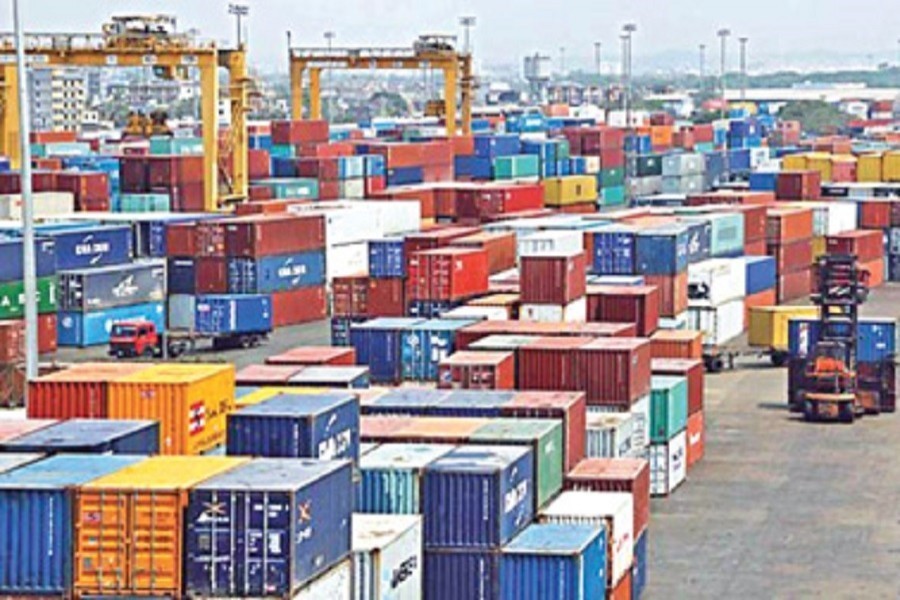The much publicised trade war is apparently poised to tear through the economy of many countries in terms of real and anticipated threats. Increasing number of regional trade agreements (RTAs) and free trade agreements (FTAs) to the point of sidestepping the multilateral trade discipline enunciated by the World Trade Organisation (WTO) are also potentially worrisome signals for unhindered flow of trade. In such a difficult time, even maintaining status quo may reasonably be lauded as an achievement.
In this backdrop, growth of exports—that too beyond more-than-moderate target—is a big feat. Bangladesh, here, is a case in point. The country has done more than expected in exports in the recent months. Obviously, it is readymade garments that spearheaded the uphill task. Surge in garment exports has pushed the country's export earnings to a record 54.64 per cent growth in September 2018. Total export earnings reached $3.14 billion in September, the third month of current fiscal (2018-19). The country fetched $2.03 billion during the corresponding period of the previous fiscal. According to the Export Promotion Bureau (EPB) data, the earnings also surpassed the target set for the month by 14.74 per cent-the highest growth achieved in a single month in Bangladesh's history. From July through September, garments exports grew 14.66 per cent year-on-year to over $8.19 billion, accounting for 82.40 per cent of the total export earnings. Of the garment products, knitwear exports rose 12.27 per cent to $4.20 billion and woven garments exports surged 17.3 per cent to almost $4 billion. Bangladesh fetched $9.94 billion from exports in the first three months of this fiscal year. The figure is 14.75 per cent higher compared with the same period of the previous year. More remarkable, it is 6.54 per cent higher than the export target for the quarter. Total export target for the current fiscal (2018-19) is $39 billion-- 6.38 per cent higher than last year's earnings.
While many attribute this surge to the more or less calm political climate in the country, others are of the opinion that besides the political climate, factory remediation (that inspired buyers to increase sourcing from the country) coupled with positive marketing drive contributed to the attainment of the feat. It is encouraging that export of garments has fared well in almost all its segments. In addition, there has been considerable growth in the export of other textile products such as terry towels and home textiles in the first quarter of this fiscal.
This, however, does not say it all. Some major export products did not experience similar performance. These include jute and jute products, leather and leather goods, frozen food (mainly shrimp). The first two products, which are projected to become the driver of the national economy, are yet to demonstrate the expected level of vigour. There has been much talk for quite some time about development of newer products and diversification in jute goods, including the recently developed jute poly bag, but attempts seem to be inadequate to capture niche markets.
There are also fears whether home textiles (mostly bed sheets, terry towels), which registered considerable growth in the first quarter of the current fiscal, would be able to sustain the momentum. The EU GSP-plus scheme has facilitated countries like Pakistan to get zero duty benefit for exporting home textiles, among other products -- that earlier they were not eligible for. Clearly, this has eroded Bangladesh's preferential duty benefit in the EU markets putting it at par with a traditional textile-producing country like Pakistan. The situation is highly challenging for the simple reason that Pakistan not only produces yarn in bulk but also meets its requirement of cotton from domestic production. Bangladesh manufacturers of home textiles may find export of their products less than cheering in near future. The very fact that terry towels and bed sheets are available in street shops in abundant quantities at throw-away prices is an evidence that this export sector is in a bad shape. Bundles of terry towels are now lodged on the shoulders of hawkers in busy road intersections of the capital and elsewhere instead of being packaged to be cotainerised for export to North America and the EU countries.
So, on the flip side of the 'feel good' effect from export growth, there are worrying factors to take into account, as part of the overall export scenario. Why aren't some of the major products—jute and leather—doing well is a matter of great concern. The impeding elements should be identified and analysed to be able to prepare and plan for necessary actions. As for home textiles, which is likely to face more challenges in the days ahead, the stakeholders including the government may sit together to assess the situation at length for finding a way out.


